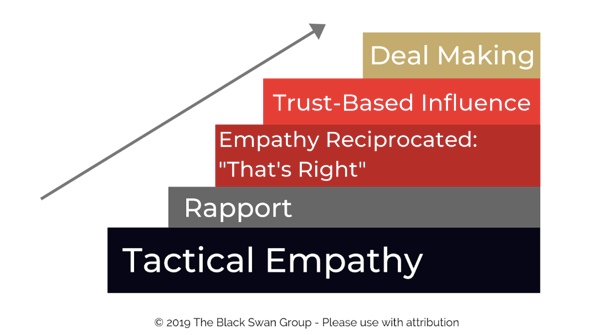Everyone who grasps the importance of that’s right is making incredible breakthroughs in their negotiations. They are killing it. And you will, too. It’s the solid gold response that is 10x better than hearing yes could ever be.
First, watch this video to understand how to get a that’s right from your counterpart.
That’s right creates breakthroughs. That’s right transforms negotiations. That’s right is what your counterpart says when they feel completely understood.
That’s right is your counterpart signaling to you that they feel empathy from you. It’s a sign that a connection has been made.
That’s right puts you on the path to trust-based influence—the most powerful and durable form of influence.
Getting a that’s right starts with an effective summary, which is really a combination of several skills you’ve already learned.
- Labels + Paraphrase = Summary
A summary is a combination of labeling and paraphrasing. It’s taking what you’ve heard so far or know to be the case about a situation, and summarizing both the known facts and content (i.e., paraphrasing), and how your counterpart feels about them (i.e., labeling).
Temporarily Putting the Brakes on Dynamic Silence
One of the reasons you will struggle with the transition from labeling to summarizing is halting (temporarily) your use of dynamic silence. Up until now, we’ve put a lot of this emphasis on dynamic silence so that you don’t step on your own labels.
But to summarize effectively, you’ve got to be ready to plow all the way through. Pull the whole thing together and swim all the way to the other side. Summarize, and summarize thoroughly.
A critical part of any effective summary is your labeling of negatives. Hang a label on the emotions and thoughts your instincts are telling you that you don’t want the other side to feel. Again, these are likely the things you may want to deny. But remember, no elephant in the room ever went away because everyone denied it was there in the first place.
Your result? Get a that’s right and you’re in a good place. Get a you’re right and you’re in a bad place.
If you can grasp this critical distinction, you’ve gained a huge advantage.
Rapport
That’s right indicates two important things:
- You are listening to them accurately.
- They realize you are listening. And in that moment of realization, of being heard, they feel empathy from you, and they genuinely appreciate it. You’re either establishing trust-based influence—or you’re cementing it.
When you get your counterpart to say that’s right, they will often look at you as if they suddenly see you in a new light—like there’s a halo around your head and they hear birds singing.
The Magic of Ownership
Actually, by saying that’s right, they have declared that what you said is correct. It’s true. They can now embrace the idea you shared without any of the reservations they may have secretly harbored because it wasn’t their idea. But since they’ve given you a that’s right, it’s become their idea, too. They’ve taken ownership of it. They feel like they’re in control and can move forward.
These are the breakthrough moments in which you find that the process has suddenly taken you into the next phase in a productive manner. You can’t always predict exactly when those will be, but you’ll be stunned by how well they work to your advantage.
It’s like an athlete who’s learned the perfect form.
Please put this idea into action and find out for yourself. Fully summarize the other side’s position, both in content (paraphrasing) and how they feel about it (labeling) until that’s right is their only possible response.
This approach will help you remove false obstacles that are holding you back. It’ll also help you create turning points in your negotiations (and in your relationships) that work for you.
Here’s some homework: Get one that’s right today. From anyone. It doesn’t matter who or in what context.
Make it your goal to get just one. Then you’ll see what kind of magic can happen.


